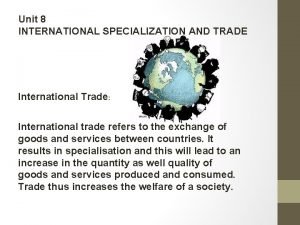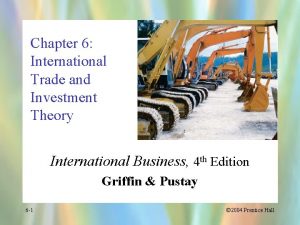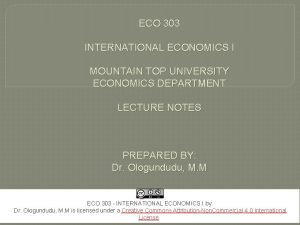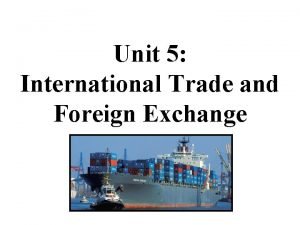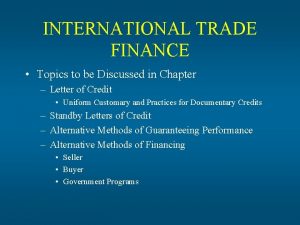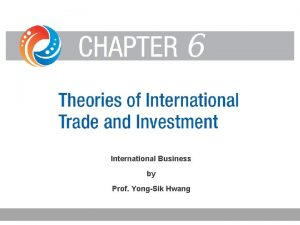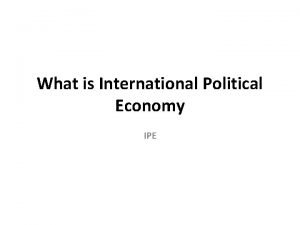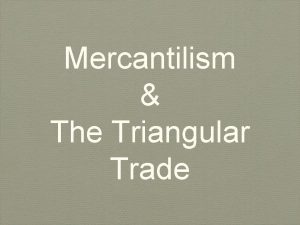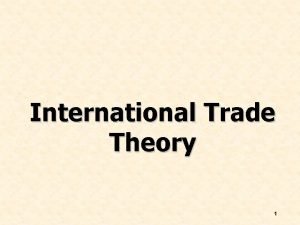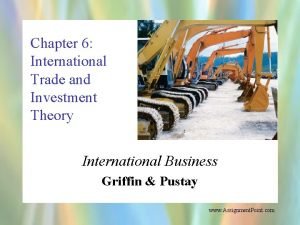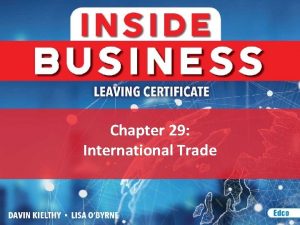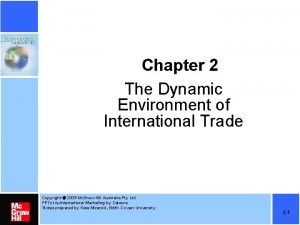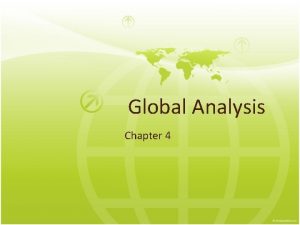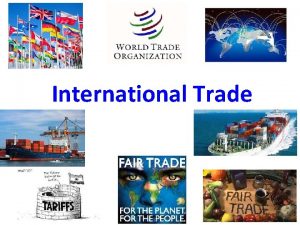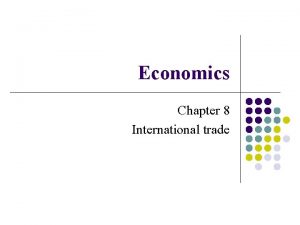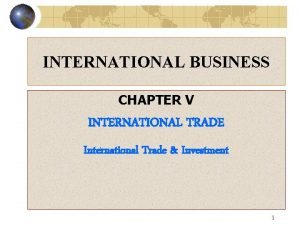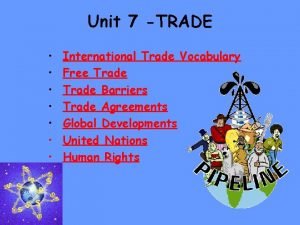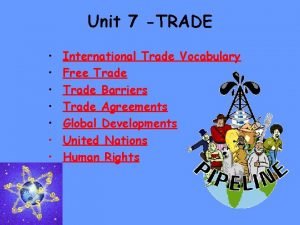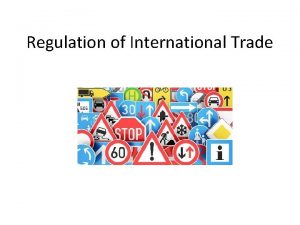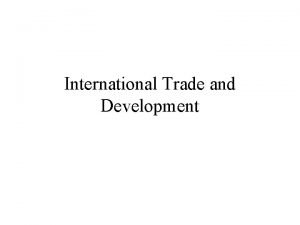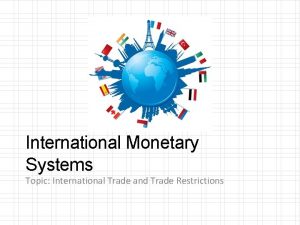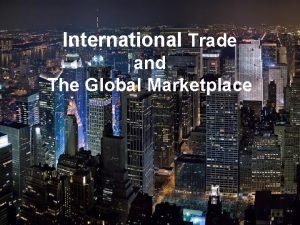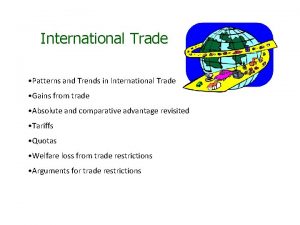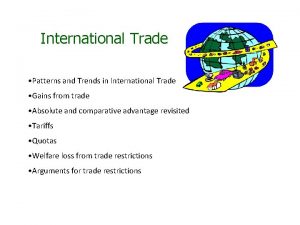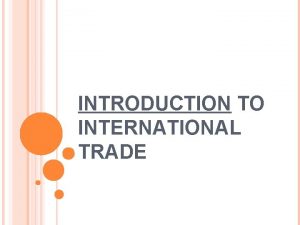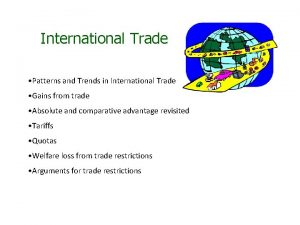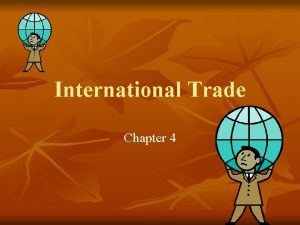International trade 1 What is international trade and

























- Slides: 25

International trade

1. What is international trade and why does it exist? 2. What is absolute and comparative advantage? 3. Why do states use protectionist tools? 4. How does exchange rate influence international trade? 11/9/2020 2

What is international trade (IT)? ─ International trade is the exchange of capital, goods, and services across international borders or territories. It is the exchange of goods and services among nations of the world. [1] In most countries, such trade represents a significant share of gross domestic product (GDP). ─ International trade is the exchange of goods and services between countries. This type of trade gives rise to a world economy, in which prices, or supply and demand, affect and are affected by global events. 3

Why IT? ─ Trading globally gives consumers and countries the opportunity to be exposed to goods and services not available in their own countries. Almost every kind of product can be found on the international market: food, clothes, spare parts, oil, jewelry, wine, stocks, currencies, and water. Services are also traded: tourism, banking, consulting and transportation. ─ A product that is sold to the global market is an export, and a product that is bought from the global market is an import. 11/9/2020 4

Why IT? ─ Global trade allows wealthy countries to use their resources (whether labor, technology or capital) more efficiently. Because countries are endowed with different assets and natural resources (land, labor, capital and technology), some countries may produce the same good more efficiently and therefore sell it more cheaply than other countries. ─ If a country cannot efficiently produce an item, it can obtain the item by trading with another country that can. This is known as specialization in international trade. 11/9/2020 5

Advantages of International Trade ─ Exports create jobs and boost economic growth. They give domestic companies more experience in producing foreign markets. Over time, companies gain a competitive advantage in global trade. ─ Imports allow foreign competition to reduce prices for consumers. It also gives shoppers a wider variety of goods and services. Examples include tropical and out-of-season fruits and vegetables. ─ International trade also allows countries to participate in a global economy, encouraging the opportunity of foreign direct investment (FDI). 11/9/2020 6

Disadvantages of International Trade ─ The only way to boost exports is to make trade easier overall. Governments do this by reducing tariffs and other blocks to imports. That reduces jobs in domestic industries that can't compete on a global scale. ─ It also leads to job outsourcing. That's when companies relocate call centers, technology offices and manufacturing. They choose countries with a lower cost of living. Countries with traditional economies could lose their local farming base. That's because developed economies subsidize their agribusiness. Both the United States and the European Union do this. That undercuts the prices of the local farmers. 7

1. What is international trade and why does it exist? 2. What is absolute and comparative advantage? 3. Why do states use protectionist tools? 4. How does exchange rate influence international trade? 11/9/2020 8

What is 'Absolute Advantage’ ─ Absolute advantage is the ability of a country, individual, company or region to produce a good or service at a lower cost per unit than the cost at which any other entity produces that same good or service. ─ Entities with absolute advantages can produce a product or service using a smaller number of inputs and/or using a more efficient process than other entities producing the same product or service. 11/9/2020 9

What is 'Absolute Advantage’ ─ For example, the United States may produce 700 million gallons of wine per year, while Italy produces 4 billion gallons of wine per year. Italy has an absolute advantage because it produces many more gallons of wine – the output – in the same amount of time – the input – as the United States. ─ Using another example, Jane can knit a sweater in 10 hours while Kate can knit a sweater in 8 hours. Kate has an absolute advantage over Jane because it takes her fewer hours to produce a sweater. 11/9/2020 10

What is 'Absolute Advantage’ ─ However, absolute advantage also explains why it makes sense for countries, individuals and businesses to trade with one another. Since each has advantages in producing certain products and services, they can both benefit from trade. So, if Jane can produce a painting in five hours while Kate needs nine hours to produce a comparable painting, Jane has an absolute advantage over Kate in painting. If both Jane and Kate specialize in the products they have an absolute advantage in and buy the products they don't have an absolute advantage in from the other entity, they will both be better off. 11

What is 'Comparative Advantage’ ─ Comparative advantage is an economic law referring to the ability of any given economic actor to produce goods and services at a lower opportunity cost than other economic actors. ─ Comparative advantage is contrasted with absolute advantage. Absolute advantage refers to the ability to produce more or better goods and services than somebody else. Comparative advantage refers to the ability to produce goods and services at a lower opportunity cost, not necessarily at a greater volume. 11/9/2020 12

Example ─ To see the difference, consider an attorney and her secretary. The attorney is better at producing legal services than her secretary and is also a faster typist and organizer. In this case, the attorney has an absolute advantage in both the production of legal services and secretarial work. ─ Nevertheless, they benefit from trade thanks to their comparative advantages and disadvantages. Suppose the attorney produces $175/hr in legal services and $25/hr in secretarial duties. The secretary can produce $0 in legal services and $20 in secretarial duties in an hour. Here, the role of opportunity cost is crucial. ─ To produce $25 in income from secretarial work, the attorney must lose $175 in income by not practicing law. Her opportunity cost of secretarial work is very high. She is better off by producing an hour's worth of legal services and hiring the secretary to type and organize. The secretary is much better off typing and organizing for the attorney; his opportunity cost of doing so is extremely low. It’s where his comparative advantage lies. 11/9/2020 13

Absolute and comparative advantage Guns Country A Country B 11/9/2020 Opp. costs Roses 20 4 80 10 2 20 Opp. costs ¼ ½ 14

Comparative advantage ─ https: //www. youtube. com/watch? v=4 r. Ufo. U 04 QJM 11/9/2020 15

1. What is international trade and why does it exist? 2. What is absolute and comparative advantage? 3. Why do states use protectionist tools? 4. How does exchange rate influence international trade? 11/9/2020 16

Free Trade or Protectionism? ─ As with other theories, there are opposing views. Free trade (laissez-faire) approach (with no restrictions on trade) idea is that supply and demand factors, operating on a global scale, will ensure that production happens efficiently. Therefore, nothing needs to be done to protect or promote trade and growth, because market forces will do so automatically. ─ In contrast, protectionism holds that regulation of international trade is important to ensure that markets function properly. Advocates of this theory believe that market inefficiencies may hamper the benefits of international trade and they aim to guide the market accordingly. 11/9/2020 17

What is 'Protectionism’ ─ Protectionism refers to government actions and policies that restrict or restrain international trade, often done with the intent of protecting local businesses and jobs from foreign competition. Typical methods of protectionism are tariffs and quotas on imports and subsidies or tax cuts granted to local businesses. ─ The primary objective of protectionism is to make local businesses or industries more competitive by increasing the price or restricting the quantity of imports entering the country. ─ Trade protectionism is also a type of policy that limits unfair competition from foreign industries. 11/9/2020 18

Advantages ─ If a country is trying to grow strong in a new industry, tariffs will protect it from foreign competitors. That gives the new industry’s companies time to develop their own competitive advantages. ─ Protectionism also temporarily creates jobs for domestic workers. The protection of tariffs, quotas or subsidies allows domestic companies to hire locally. ─ This benefit ends once other countries retaliate by erecting their own protectionism. 11/9/2020 19

Disadvantages ─ In the long term, trade protectionism weakens the industry. Without competition, companies within the industry have no need to innovate. There's no need to. Eventually, the domestic product will decline in quality. It will be lower quality and more expensive than what foreign competitors produce. ─ It can also lead to job outsourcing and slower economic growth. ─ These are the reasons for free trade agreements between countries that often lead to closer economic integration. 11/9/2020 20

1. What is international trade and why does it exist? 2. What is absolute and comparative advantage? 3. Why do states use protectionist tools? 4. How does exchange rate influence international trade? 11/9/2020 21

Exchange rate 1, 4 $ 1 € 0, 833 € 1 $ 1, 2 $ 1 € 0, 714 € 1 $

Exchange rate 25 CZK/€ rate 28 CZK/€ Price in CZ Price in DE 10 000 € 8 928 € 250 000 Kč

Understand this! ─ Depreciation of currency (exchange rate rises) tends to higher exports and lower imports. ─ On the other side higher exports then makes currency stronger (exchange rate falls down) = currency appreciates. ─ Appreciation of currency (exchange rate falls down) tends to lower exports and higher imports. ─ And again higher imports makes currency weaker ─ Of course the circle may continue…. 11/9/2020 24

Thank you for your attention 11/9/2020 25
 Trade diversion and trade creation
Trade diversion and trade creation Trade diversion and trade creation
Trade diversion and trade creation Which is the most enduring free trade area in the world?
Which is the most enduring free trade area in the world? Trade diversion and trade creation
Trade diversion and trade creation Tramp chartering
Tramp chartering Unit 8
Unit 8 Chapter 6 theories of international trade and investment
Chapter 6 theories of international trade and investment Certificate in international trade and finance citf
Certificate in international trade and finance citf Kravis theory
Kravis theory Unit 5 international trade
Unit 5 international trade International trade and finance topics
International trade and finance topics Theories of international trade and investment
Theories of international trade and investment The trade in the trade-to-gdp ratio
The trade in the trade-to-gdp ratio Fair trade not free trade
Fair trade not free trade Triangular trade video
Triangular trade video Marxism in international political economy
Marxism in international political economy Mercantilism theory of international trade
Mercantilism theory of international trade Current theory of international trade adalah
Current theory of international trade adalah Classical theories of international trade
Classical theories of international trade International trade theory
International trade theory International trade theory
International trade theory International trade vocabulary
International trade vocabulary Importance of international trade
Importance of international trade Dynamic environment of international trade
Dynamic environment of international trade International trade defination
International trade defination Benefits of international trade
Benefits of international trade





